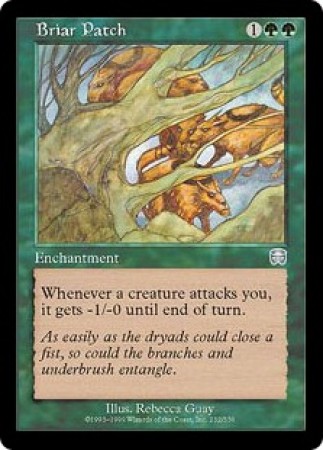Herbs, Spices and Medicinal Vegetables
<WARNING>
<in general, please do
NOT ingest any of the following without prior consultation with an herbalist
and/or a physician>

<WARNING>
<in general, please do
NOT ingest any of the following without prior consultation with an herbalist
and/or a physician>

|
|
|
|
|
|
|
|
|
|
|
|
There are hundreds of different vegetable
flavorings and seasonings
which were or are reputed to have medicinal
and/or magic properties. It is
not within the scope of this work to detail
all of these herbs and spices,
particularly as regards their description,
habitat, and the many uses
claimed for most. An alphabetical listing
with one or two comments on
each is presented. The dedicated herbologist
will have to pursue his or her
research in scholarly texts.
It is suggested that you use the above
list as a guide to which herbs, spices, or vegetable
you will require for various magical effects desired from potions,
scroll inks, and other magic items.
You may add to or delete from the list
as you desire.
Reputed folk uses are not detailed with
respect to magic in most cases, as this decision is the purview of the
DM.
You may add to or delete from the list as you desire. <(DMG.221)>
<cannabis sativa>

<coca leaf>
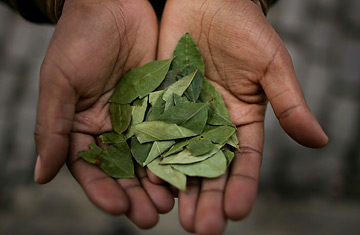
<sacred mushroom>
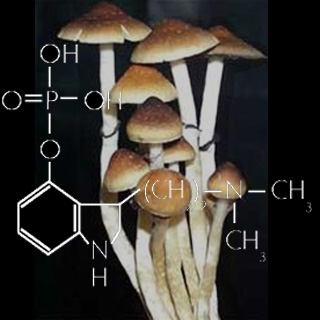
< find the species that was used by the classical Mayans as a social
"droog" >
< note that if it is pure Nature, it is a fungus, NOT a droog >
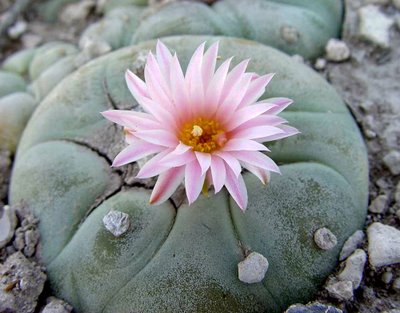
| Plant And/Or Special Part: | Species (approx.) | Uses And/Or Powers: | Reference |
| aster <example of color: aster> | 100 | - | EX1.6 |
| 4pm flower (four o'clock flower) | 290 | - | EX1.6 |
| short sword lily (gladiolus) | 260 | - | EX1.6 |
| - | - | - | - |
| savory | ? | ? | PH.67 (find familiar) |
-
Scientific name (Binomial):
Appearance:
Location:
Uses:
Game Effect:
Precautions:
FLORA CATEGORIES
1. Bushes & Shrubs
2. Flowers
3. Fungi
4. Grasses & Grains
5. Herbs
6. Mosses & Ferns
7. Trees
8. Weeds
| Plant And/Or Special Part: | Uses And/Or Powers: | Image | Location | Category | Game Effect
[The Simple AD&D Herbal] |
Precautions | Notes: |
| abcess root (sweet root) | respiratory disorders | - | - | - | - | - | - |
| acacia (Gum Arabic) | tissue repair | - | Africa (The Sahel). | Tree | - | - | * used for an invisibility spell.
Gum Arabic, 81-87, a plant used in adhesives, confectionary and pharmacy. (BD1.41) |
| aconite
(monkshood, wolfsbane, friar's cap, etc.) |
sedative/drives off werewolves
Q. What is the effect
of wolvesbane on
|
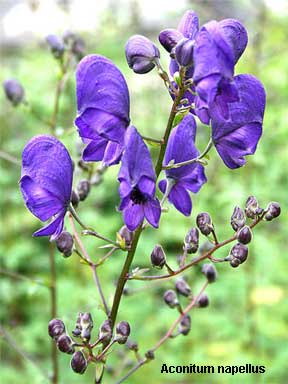 |
Mountains. China, Greece, India, Japan. | Flower | - | - | *!* poison *!*
* possible ingredient for a potion of flying. 1 sp (C&S 2e) 10 gp for 1 bunch (B/X) Lethal dose:
cf. The Toxicology of Botanical Medicines, 3rd edition. Francis
Brinker, N.D..
|
| acorn | tissue hardening | - | - | - | - | - | - |
| adder's tongue | emetic, emollient | - | - | - | - | - | - |
| adrue | anti-vomiting, sedative | - | - | - | - | - | - |
| agar-agar (jelly) | anti-inflammation, nutrient | - | - | - | - | - | - |
| agaric | astringent, purgative | - | - | - | - | - | - |
| agrimony (cockleburr, stickwort) | muscle toner, diuretic | - | - | - | - | - | - |
| alder | anti-inflammation, tonic | - | - | - | - | - | - |
| alkanet root | emollient, antiseptic, wormer | - | - | - | - | - | - |
| all-heal (wound-wort) | antiseptic, anti-spasmodic | - | - | - | - | - | - |
| almond milk/powder | nutrient/emollient | - | - | Tree | - | - | 1 cp (C&S 2e) |
| aloe (bitter aloe) | bites, burns, laxative, tonic/insect repellant | - | - | - | - | - | 3 cp (C&S 2e) |
| amaranth
(red cockscomb, love-lies-bleeding) |
astringent, anti-hemorrhaging |  |
- | - | - | - | |
| ammoniacum (Persian Gum) | stimulant, respiratory aid | - | - | - | - | - | - |
| angelica | lungs, liver, spleen, vision, hearing | - | - | - | - | - | - |
| anise | antacid, digestion, coughing | - | - | - | - | - | 1 cp (C&S 2e)
aniseed: 1 sp (C&S 2e) |
| arbutus (mayflower) | astringent, bladder infection | - | - | - | - | - | - |
| areca nut (betel nut) | astringent, tape wormer | - | - | - | - | - | - |
| arenaria rubra (sandwort) | diuretic, urinary diseases | - | - | - | - | - | - |
| arrach (goosefoot) | sedative (nervous tension or hysteria in particular) | - | - | - | - | - | - |
| atichoke juice | jaundice curative | - | - | - | - | - | - |
| asafetida (gum asafetida, devil's dung, food of the gods) | aphrodisiac, brain and nervous stimulant, tonic, many more | - | - | - | - | - | - |
| asarabacca (hazelwort, wild nard) | emetic, purgative | - | - | - | - | - | nard: 1 sp (C&S 2e) |
| ash (bark and leaves of) | laxative, anti-inflammation, fever | - | - | - | - | - | Ash wood (seasoned), 40-53#
per cu. ft. (BD1.41)
3-5 cp (C&S 2e) |
| asparagus juice/root | sedative, heart problems/anti-oxalic acid | - | - | - | - | - | - |
| avens (colewort, herb bennet) | astringent, anti-hemorrhaging, anti-weakness, tonic, more | - | - | - | - | - | - |
| bael | anti-inflammation, ulcers | - | - | - | - | - | - |
| balm (sweet balm) leaves | calms nerves, fevers | - | - | - | - | - | - |
| balm of gilead | nutrient, organ stimulant (general) | - | - | - | - | - | balm: 8 cp (C&S 2e) |
| balmony (bitter herb, snake head) | tissue builder and strengthener, liver ailments, wormer | - | - | - | - | - | - |
| barley | nutrient (recuperative) | - | - | - | - | - | - |
| basil | nervous disorders | - | - | - | - | - | 7 cp (C&S 2e) |
| bay leaf | ? | - | - | - | - | - | - |
| beet | organic cleanser | - | - | - | - | - | beetroot: market* (C&S 2e) |
| belladonna
(deadly nightshade, dwale, black cherry root) |
diuretic, sedative, pain reliever, anti-opiate, circulation, stimulant, poison/lycanthropy cure | <get clearer photograph>
|
Greece, Rome, Europe, North Africa, West Asia. | - | +1 comeliness (w) | - | *!* poison *!*
* Lycanthropy cure: If the person is carrying belladonna there is a 25% chance that this will cure the affliction if it is eaten within 1 hour. Note that this infusion will incapacitate the victim for 1-4 days and there is a 1% chance that the poison in the belladonna will kill. (MM2.80). * BD4=x * "There is currently insufficient scientific evidence to recommend the use of A. belladonna in its natural form for any condition,[13] although some of its components, in particular l-atropine which was purified from belladona in the 1830s, have accepted medical uses." (1) * possible ingredient for a potion of flying. 25 cp (C&S 2e) |
| benne (sesam, sesame) | respiratory disorders, eye infections, more (youth, beauty: Babylon, strength, energy: Rome) | - | Tropical: Africa, India, Babylon, Rome | - | - | - | - |
| benzoin (gum benzoin) | expectorant, stimulant, antiseptic, wounds and sores | - | - | - | - | - | - |
| berberis | fevers | - | - | - | - | - | - |
| beth root (lamb's quarters) | astringent, coughs, tonic, anti-hemorrhaging, more | - | - | - | - | - | - |
| bilberry
(huckleberry, hurtleberry, whortleberry) |
anti-thirst, dropsy, typhoid, more <> | - | - | shrub | - | - | dropsy : would that help with the 2ndary effects cystic fibrosis? |
| birch (white birch) | intestines and stomach, venereal diseases, skin conditions | - | - | - | - | - | birchbark: 1 cp (C&S 2e) |
| birthwort | circulatory stimulant | - | - | - | - | - | - |
| bistort (adderwort) | astringent | - | - | - | - | - | - |
| bittersweet
(felonwort, scarlet berry, woody nightshade) |
abcesses, lymph infections, swelling and inflammation | - | - | - | - | - | - |
| blackberry (dewberry) | astringent, tonic, dysentary | - | native to temperate northern hemisphere and S. America | flower | - | - | brambles contain blackberries.
should not be picked after oct. 11, as Satan has claimed them. |
| black currant | diuretic, antiseptic, blood purifier | - | - | Sh(f) | - | - | - |
| black willow (pussy willow) bark | astringent, antiseptic | - | - | Tree | - | - | Willow wood (seasoned), 24-37# per cu. ft. (BD1.41) |
| blueberry -- see bilberry <x> | anti-thirst, dropsy, typhoid, more <> | - | - | - | - | - | - |
| blue flag
(flag lily, poison flag, water flag, water lily) |
diuretic, cathartic, blood purifier (vs. poison), wound healing, venereal disease, much more | 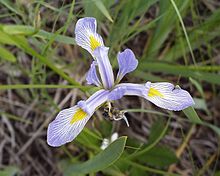 |
- | - | - | - | - |
| blue mallow (common mallow) | coughs, colds | - | - | - | - | - | - |
| boneset (thoughtwort) | fevers, tonic, skin diseases | - | - | - | - | - | 25 cp (C&S 2e) |
| borage | coughs, lung infections | - | - | - | - | - | - |
| box leaves | tonic, blood purifier | - | - | - | - | - | - |
| bryony | paralysis, bruises | - | - | - | - | - | - |
| bugle | gastrointestinal disorders, hemmorhaging | - | - | - | - | - | - |
| burdock | laxative, tuberculosis, more | - | - | - | - | - | also the name of a place
2 cp (C&S 2e) |
| butterbur | fevers, urinary complaints | - | - | - | - | - | - |
| cabbage juice | ulcer and stomach treatment | - | Greece, Rome. Mediterranean. | - | - | - | - |
| calotopis (mudar bark) (calotropis) | skin leprosy, elephantiasis, more | - | - | - | - | - | paralysis cure?
found in: India |
| camphor (gum camphor) | bruises, sprains, chills, fevers, cardiac stimulant | - | Taiwan, southern Japan, southeast China and Indochina | Tree, Flower | - | - | The bisan is associated with camphor
trees.
Camphor, 62 pounds per cubic foot, aspirin variant (BD1.23) Resin (Common, 1 gp/oz. for ordinary sort; Uncommon, 5 gp/oz. for resin from camphor tree): alchemist, musical instrument shop, painter, paper/ink maker, physician (BD4) |
| caraway | antacid, aids digestion | - | - | - | - | - | - |
| cardamom | ? | - | - | - | - | - | - |
| carrot juice and seeds | tonic for improved health | - | Iran, Afghanistan | Flower | - | - | - |
| castor oil bush | purgative, cathartic | - | - | - | - | - | Elixir made from
the juice of dried plums and the oil of 5-8 beans of a castor plant (rare;
50 gp/oz.) (BD4.38)
Plums, dried (common; 2 cp/dozen): food store (BD4.39) Castor beans (rare; 10 gp/oz.): alchemist, dyer, perfumer, physician (Castor beans are native to tropical Asia and Africa, and are common in similar climates.) (BD4.38) |
| catnip | colds, fevers, anti-spasmodic, hysteria | - | Europe, Asia, Africa | H | - | - | - |
| cayenne | stimulant | - | Tropical | - | - | - | - |
| celery | liver functions | - | Egypt, Greece | - | - | - | - |
| chamomile <(camomile)> | nervous conditions, ear and tooth aches | - | - | - | - | - | 1 cp (C&S 2e) |
| chaulmoogra oil | fevers, sedative, skin eruptions | - | - | - | - | - | - |
| cherry gum | respiratory infections/food substitute | - | - | - | - | - | - |
| chervil | ? | - | - | - | - | - | 4 cp (C&S 2e) |
| chives | colds, general diseases/evil eye | - | - | - | - | - | 1 cp (C&S 2e) |
| cinnamon | disinfectant, nausea, preservative | - | Egypt | - | - | - | most cinnamon in N. American is cassia |
| cleavers (goosegrass) | fevers, circulation, blood purifier, wounds, liver disease | - | - | - | - | - | - |
| clover | tonic | - | - | - | - | - | 1 sp (C&S 2e) |
| cloves | anaesthetic, circulation, germicide, disinfectant | - | - | - | - | - | 3 cp (C&S 2e) |
| comfrey root (healing herb) | colds, respiratory conditions, wounds, bone fractures, gangrene, much, much more | - | - | - | - | - | 1 sp (C&S 2e) |
| coriander | tonic | - | - | - | - | - | - |
| couchgrass | bladder and urinary infections | - | - | - | - | - | - |
| cucumber | inflammation | - | - | - | - | - | A:
L: U: G: P: |
| cumin seed | stimulant | - | - | - | - | - | - |
| dandelion | diuretic, purgative, tonic | - | - | - | - | - | - |
| digitalis
(dead men's bells, fairy bells, fairy cap, fairy fingers, foxglove, etc.) |
heart stimulant, tonic, kidney treatment (poison) | - | - | - | - | - | 1 cp (C&S 2e) |
| dill | nausea | - | - | - | - | - | - |
| ergot (rye smut) | hemmorhaging*, venereal diseases |
Source: 100 Bushels of Rye 50 |
Africa, Greece, Norse, Tropical | G(Fun) | - | - | - |
| eyebright | astringent, eye infections | - | - | - | - | - | - |
| fennel | digestion, weight control, muscle tone, reflexes, vision, much, more | - | - | - | - | - | - |
| fenugreek | stimulant | - | - | - | - | - | - |
| fig | demulcent | - | native to Middle East and western Asia (Middle Eastern and Meditteranean climate: subtropical, probably). grown in temperate regions. found in the desert and mountains of Iran. | flower, tree, shrub | - | - | sacred to Dionysus |
| figwort (scrofula plant, throatwort) | abcesses, wounds, pain killer | - | - | - | - | - | - |
| fireweed | astringent, anti-spasmodic | - | - | - | - | - | - |
| fluellin | astringent, tissue strengthener | - | - | - | - | - | - |
| garden burnet | ? | - | - | - | - | - | - |
| garlic | coughs, colds, blood purifier, detoxifier, kills parasites/wards off vampires | - | Forests:
Native to Central Asia |
- | - | - | see BD4.70 |
| gelsemium (wild woodbine) | sedative, nerve tonic, fevers, more | - | - | - | - | - | Long Liyuan (Guangdong) |
| gentian (bitter root, felwort) | tonic, fevers, anti-venom | - | Native to temperate Asia, Europe, and Americas | Flower | - | - | A:
L: U: G: P: |
| geranium (sweet geranium) | alkalizer | - | - | Flower | - | - | 1 sp (C&S 2e) |
| ginger
(Zingiber officinale) |
stimulant, colds, cramps | - | Subtropical:
south Asia, India, China, Japan (modern: east Africa, Greece) |
Shrub? | - | - | A:
L: U: Figging (Feaguing). G: P: class A safety rating 5 sp (C&S 2e) |
| ginseng
(Quebec ginseng?) (called American ginseng, but Quebec ginseng might be better) (see mistletoe, and remember the ecology of Greyhawk. i strongly suggest Quebec ginseng as a default, but this needs to be mapped to the Uses and/or Powers) |
glandular stimulant, vision, dizziness, headaches, weakness | - | - | - | - | - | - |
| goat's rue | diuretic, wormer (vermifuge) | - | - | - | - | - | rue: 1 cp (C&S 2e) |
| grape juice | blood fortifier | - | Greek | - | - | - | - |
| hartstongue | cough, liver, spleen, bladder | - | - | - | - | - | - |
| hawthorn | heart, arteries | - | - | - | - | - | - |
| hedge mustard | throat, lungs | - | Europe, North Africa
Used as a condiment in Denmark, Norway. Greeks considered it an antidote to all poisons. |
weed | - | - | A:
L: wastelands, roadsides U: G: P: |
| hellebore | heart tonic (rootlets are poison) | - | - | - | - | - | - |
| honeysuckle | liver, spleen, respiratory disorders | - | - | - | - | - | - |
| horehound, white | coughs, pulmonary diseases, anti-venom | - | - | - | - | - | horehound: 2 cp (C&S 2e) |
| horehound, black | stimulant, wormer, hemmorhaging | - | - | - | - | - | horehound: 2 cp (C&S 2e) |
| horseradish | tonic, antiseptic, wormer | - | - | - | - | - | - |
| hyssop | respiratory ailments, jaundice, blood purifier, tonic, cuts and wounds, more | - | - | - | - | - | 7 cp (C&S 2e) |
| ipecac | dysentary, mouth infections, more | - | - | - | - | - | - |
| irish moss | coughs, scalds, burns | - | - | - | - | - | - |
| jambul seed | blood purifier, diabetes | - | - | - | - | - | - |
| jewel weed (balsam weed, pale touch-me-not) | diuretic, kidneys, skin growths, fungus, infections, liver | - | - | - | - | - | - |
| juniper berry | aphrodisiac, stimulant, disinfectant, venereal disease, more | - | - | - | - | - | juniper: 3 cp (C&S 2e) |
| jurubera | anemia | - | - | - | - | - | - |
| kelp (seawrack) | thyroid, heart, arteries, much more | - | - | - | - | - | - |
| larkspur (knight's spur) | external parasites | - | - | - | - | - | - |
| leek | same as chives <> | - | - | - | - | - | - |
| lily-of-the-valley | heart tonic | - | - | - | - | - | - |
| lotus | ? | - | - | - | - | - | 125 sp (C&S) |
| lucerne (alfalfa) | strength | - | - | - | - | - | - |
| lycopodium (common club moss, fox tail, lamb's tail) | wounds, lungs, kidneys, more | - | - | - | - | - | - |
| mace | stimulant | - | India. | Tree | - | - | Tree, Seed (outer covering).
"mace is the dried "lacy" reddish covering or aril" of the nutmeg seed (1) 2 cp (C&S 2e) |
| marigold | fevers, variscosities, eyes, heart | - | - | - | - | - | 1 sp (C&S 2e)
Marigold: (Common; 1 cp/ea.): druid, flower shop, gathering (BD4) |
| marjoram | meloncholia, dizziness, brain disorders, toothaches | - | - | - | - | - | 1 cp (C&S 2e) |
| masterwort | stimulates organs, anti-spasmodic, more | - | - | - | - | - | - |
| mistletoe | convulsions, hysteria, narcotic, tonic, typhoid fever, heart | - | Celtic, Greece. | - | - | - | 1 sp (C&S 2e) |
| muira-puama | aphrodisiac | - | - | - | - | - | - |
| mustard | emetic, counter-irritant, colds, fevers | - | - | - | - | - | A:
L: U: G: P: |
| nutmeg | nausea, vomiting, diarrhea | - | India. | - | - | - | Tree, Seed.
See mace. 5 cp (C&S 2e) |
| nux vomica (poison nut) | stimulant, debility tonic | - | - | - | - | - | - |
| onion | poultice, colds (as chives) | - | Egypt, Greece, North America | - | - | - | - |
| oregano | germicide, pain killer | - | - | - | - | - | 1 cp (C&S 2e) |
| paprika | stimulant, poultice | - | Subtropical?
Greece. |
- | - | - | - |
| parsley | blood purifier | - | Subtropical Coast: | - | - | - | 1 cp (C&S 2e) |
| parsnip | fevers | - | - | - | - | - | - |
| peach seed | fevers, blood tonic | - | - | - | - | - | - |
| pepper, black | sprains, neuritis | - | Tropical:
China, Egypt, India |
- | sprains, neuritis = herbalism/wounds (blunt & falling damage only),
-1 step of pain (see Dragon 118)? (neuritis: neural inflammation) [4 oz
= 2 sp]
AMC for darkness spells. used in the making of a wand of negation. used in black magic (cf. DLA), as an AMC for any 1st level spell. [spice, pepper, Durparian black: 1 oz = 30 gp] [crackers, pepper (3 dozen per package): 5 $p / package, AWRC.119] (DMG.219) |
- | * black peppercorns may be found stuffed in the nostrils of mummies
as part of the mummification ritual.
* 1 g.p./ounce (DMG) |
| peppermint | ? | - | - | - | - | - | - |
| pitcher plant | small pox preventative and cure, stomach, liver, kidneys | - | - | - | - | - | - |
| plantain (ripple grass, waybread) | minor wounds, stings, rashes | - | - | - | - | - | <White Man's footprint>
<Spit poultice> <plantago lanceolata?> <Marc Williams, youtube> |
| pomegranate | nerve sedative, wormer | - | - | - | - | - | - |
| poppy | ? | - | Babylon, Mesopotamia. | - | - | - | <cf wikipedia ... what the preferred
species(?) used in the temples ... not somniferum?>
* possible ingredient for a potion of flying. red poppy: 25 sp (C&S 2e) opium/laudnum: 25-50 sp (C&S 2e) poppy seed: 1 sp (C&S 2e) |
| pumpkin seed | virility, organ tonic | - | - | - | - | - | - |
| quince | eye disease, dysentary, skin disorders | - | - | - | - | - | - |
| radish | blood purifier, liver | - | - | - | - | - | - |
| raspberry | fevers, tonic | - | - | - | - | - | - |
| rhubarb | astringent, cathartic | - | - | - | - | - | Rhubarb leaf, powdered (Uncommon; 5 sp/oz.): alchemist, herbalist (BD4) |
| rose <(@~)~~~~)> | colds, fevers | - | - | - | black: 250
sp (C&S 2e)
purple: 125 sp (C&S 2e) red:25 sp (C&S 2e) yellow/white: 25 sp (C&S 2e) |
||
| rosemary | germicide, muscle tonic/drives off evil spirits | - | warm | - | - | - | might be used in ceremony: marriage.
used to flavor oil & vinegar. 25 cp (C&S 2e) |
| saffron | scarlet fever, measles, respiratory disorders | - | - | - | - | 50 cp (C&S 2e)
"A tin box filled with yellow powder (saffron, worth 5 gp)" - T1-4.53 Lethal dose:
Aka: Autumn crocus, Spanish saffron cf. The Toxicology of Botanical Medicines, 3rd edition. Francis
Brinker, N.D..
|
|
| sage (advice) | tonic, wounds, * | - | - | shrub, flower | - | - | 2 cp (C&S 2e) |
| sarsaparilla (china root, spikenard) | system balance, blood purifier, venereal disease, many more | - | - | - | - | - | - |
| scopolis | nerve and muscle sedative, pain killer, coughs | - | - | - | - | - | - |
| scullcap (madweed) | nervous disorders, rabies | - | - | - | - | - | - |
| senna | purgative | - | - | - | - | - | 1 sp (C&S 2e) |
| spearmint
|
? | - | - | - | - | - | 3 cp (C&S 2e) |
| strawberry | vision, swelling and inflammation | - | - | - | - | - | - |
| summer savory | blood purifier, palsy | - | - | - | - | - | - |
| tamarind | infection, gangrene | - | Native: Africa
Climate: Sub-tropical, Tropical (most common in South Asia) |
Tree | - | - | - |
| tansy | tonic, narcotic, wormer | - | - | - | - | - | 1 cp (C&S 2e) |
| tarragon | ? | - | - | - | - | - | - |
| tea | poison antidote | - | Tropical, subtropical, China, India, Japan | - | - | - | - |
| thyme | antiseptic, blood purifier | - | wild around the Mediterranean.
Egypt, Rome |
Shrub | - | - | used in mummification.
used to flavor oil & vinegar. 1 cp (C&S 2e) |
| turmeric | ? | - | - | - | - | - | - |
| watercress | blood tonic (anemia) | - | - | - | - | - | - |
| white bryony (mandragora) | cathartic, respiratory diseases, heart, kidneys | - | - | - | - | - | - |
Question: My recipe
for pork sausage seems to have a
mistake in it—it calls for
four cups of sage. This amount
seems a little excessive.
Could it be a misprint?
Answer: Yes, the recipe
should call for four tablespoons of sage.
Question: I am interested in acquiring large amounts of sage. Where should I look?
Answer: Try the yellow
pages of your phone book. Look under “Herb dealers—Sage”.
Question: In the folk
song “Scarborough Fair” there is a line that goes,“Parsley, something,
rosemary, and thyme.”
What word am I missing?
Answer: Sage.
RANDOM HERB GENERATION
* roll d6, if 4-6:
+ 100
* roll d100
1. abcess root (sweet root)
2. acacia (Gum Acacia)
3. aconite (monkshood, wolfsbane, friar's
cap, etc.)
4. acorn
5. adder's tongue
6. adrue
7. agar-agar (jelly)
8. agaric
9. agrimony (cocklebur, stickwort)
10. alder
11. alkanet root
12. all-heal (wound-wort)
13. almond milk/powder
14. aloe (bitter aloe)
15. amaranth (red cockscomb, love-lies-bleeding)
16. ammoniacum (Persian Gum)
17. angelica
18. anise
19. arbutus (mayflower)
20. areca nut (betel nut)
21. arenaria rubra (sandwort)
22. arrach (goosefoot)
23. artichoke juice
24. asafetida (gum asafetida, devil's
dung, food of the gods)
25. asarabacca (hazelwort, wild nard)
26. ash (bark and leaves of)
27. asparagus juice/root
28. avens (colewort, herb bennet)
29. bael
30. balm (sweet balm) leaves
31. balm of gilead
32. balmony (bitter herb, snake head)
33. barley
34. basil
35. bay leaf
36. beet
37. belladonna (deadly nightshade, dwale,
black cherry root)
38. benne (sesam, sesame)
39. benzoin (gum benzoin)
40. berberis
41. beth root (lamb's quarters)
42. bilberry (huckleberry, hurtleberry,
whortleberry)
43. birch (white birch)
44. birthwort
45. bistort (adderwort)
46. bittersweet (felonwort, scarlet berry,
woody nightshade)
47. blackberry (dewberry)
48. black currant
49. black willow (pussy willow) bark
50. blueberry -- see bilberry
51. blue flag (flag lily, poison flag,
water flag, water lily)
52. blue mallow (common mallow)
53. boneset (thoughtwort)
54. borage
55. box leaves
56. bryony
57. bugle
58. burdock
59. butterbur
60. cabbage jucie
61. calotopis (mudar bark)
62. camphor (gum camphor)
63. caraway
64. cardamom
65. carrot juice and seeds
66. castor oil bush
67. catnip
68. cayenne
69. celery
70. chamomile
71. chaulmoogra oil
72. cherry gum
73. chervil
74. chives
75. cinnamon
76. cleaves (goosegrass)
77. clover
78. cloves
79. comfrey root (healing herb)
80. coriander
81. couchgrass
82. cucumber
83. cumin seed
84. dandelion
85. digitalis (dead men's bells, fairy
bells, fairy cap, fairy fingers, foxglove, etc.)
86. dill
87. ergot (rye smut)
88. eyebright
89. fennel
90. fenugreek
91. fig
92. figwort (scrofula plant, throatwort)
93. fireweed
94. fluellin
95. garden burnet
96. garlic
97. gelsemium (wild woodbine)
98. gentian (bitter root, felwort)
99. geranium (sweet geranium)
100. ginger
101. ginseng
102. goat's rue
103. grape juice
104. hartstongue
105. hawthorn
106. hedge mustard
107. hellebore
108. honeysuckle
109. horehound, white
110. horehound, black
111. horseradish
112. hyssop
113. ipecac
114. irish moss
115. jambul seed
116. jewel weed (balsam weed, pale touch-me-not)
117. juniper berry
118. jurubera
119. kelp (seawrack)
120. larkspur (knight's spur)
121. leek
122. lily-of-the-valley
123. lotus
124. lucerne (alfalfa)
125. lycopodium (common club moss, fox
tail, lamb's tail)
126. mace
127. marigold
128. marjoram
129. masterwort
130. mistletoe
131. muira-puama
132. mustard
133. nutmeg
134. nux vomica (poison nut)
135. onion
136. oregano
137. paprika
138. parsley
139. parsnip
140. peach seed
141. pepper, black
142. peppermint
143. pitcher plant
144. plantain (ripple grass, waybread)
145. pomengranate
146. poppy
147. pumpkin seed
148. quince
149. radish
150. raspberry
151. rhubarb
152. rose
153. rosemary
154. saffron
155. sage
156. sarsaparilla (china root, spikenard)
157. scopolis
158. scullcap (madweed)
159. senna
160. spearmint
161. strawberry
162. summer savory
163. tamarind
164. tansy
165. tarragon
166. tea
167. thyme
168. turmeric
169. turnip
170. watercress
171. white bryony (mandragora)
Somewhere at the back part of the 1979 DMG for ADandD 1st edit. is
a list of natural herbs as medicine.
When I saw and read that info., I started using oregano for my teeth
because it is a germicide and painkiller.
Pepper is good for sprains and I think something else, but I forgot.
Is that list of medicinal herbs true for real life?
If it is, you might want to try some of those natural remedies listed
instead of unnatural medicine for your health.
I have noticed that doctors don't give all the info. that is cheapest
and the most useful.
Your 1979 DMG for ADandD 1st edit.
has helped me in real life and it might help you.
Just choose a herb that you think matches the symptoms that you
have and that doesn't have any side effects that you can think of.

As I recall, the list of herbal remedies was taken from actual books
listing such natural medicications.
In that vein I do plan to check into chelation therapy soon.
Gary
soporifics: belladonna (1),
COLDS: blue mallow, catnip, chives, comfrey root (healing herb), garlic, ginger, mustard, onion, rose
FEVERS
ash (bark and leaves of)
balm (sweet balm) leaves
berberis
boneset (thoughtwort)
butterbur
camphor (gum camphor)
catnip
chaulmoogra oil
cleavers (goosegrass)
gelsemium (wild woodbine)
gentian (bitter root, felwort)
marigold
mustard
parsnip
peach seed
raspberry
rose
FEVER \ SCARLET
saffron
FEVER \ TYPHOID
mistletoe
PAIN KILLERS
figwort (scrofula plant, throatwort)
oregano
scopolis
STIMULANTS, GENERAL (DMG.J)
ammoniacum (Persian Gum)
balm of gilead
belladonna (deadly nightshade, dwale, black cherry root)
benzoin (gum benzoin)
cayenne
cumin seed
fenugreek
ginger
horehound, black
juniper berry
mace
nux vomica (poison nut)
paprika
STIMULANTS, SPECIFIC (DMG.J)
asafetida (gum asafetida, devil's dung, food of the gods) [brain and
nervous stimulant]
birthwort [circulatory stimulant]
camphor (gum camphor) [cardiac stimulant]
digitalis (dead men's bells, fairy bells, fairy cap, fairy fingers,
foxglove, etc.) [heart stimulant]
ginseng [glandular stimulant]
URINARY
arenaria rubra (sandwort) (urinary diseases)
butterbur (urinary complaints)
couchgrass (bladder and urinary infections)
A. Game
Note: These do not stack, unless otherwise
noted.
Disinfectant = reduces severity (mild,
severe, terminal) of a disease by one step || -1 on the d8 severity die
roll (does stack, but not for the same herb).
B. Real-Life
To answer the above query, more often
than not.
To do: incl. a bibliography of all my
herbals (a dedication to plant lore).
BIBLIOGRAPHY
Herbally Yours, by Penny C. Royal (Sound Nutrition)
Desk Reference to Nature's Medicine, by Steven Foster and Rebecca
L. Johnson (National Geographic)
The Toxicology of Botanical Medicines, Third Edition, by Francis Brinker,
N.D. (Eclectic Medical Publications)
Magical Herbalism: The secret craft of the wise, by Scott Cunningham
(Llewellyn)
Foods That Harm, Foods That Heal: An A- to Z- guide to safe and healthy
eating, with Dr. Joe Schwarcz and Fran Berkoff, R.D. (Completely revised
and updated) (Reader's Digest)
Herbal Home Doctor: Herbal, homeopathic and ayurvedic remedies -- achieving
vital whole health from nature's medicine chest, by Robin Hayfield, Sue
Hawkey, Sally Morningstar (Hermes House)
The Book of Herbs: An illustrated A-Z of the world's most popular culinary
and medicinal plants, by Barty Phillips. (Capella)
